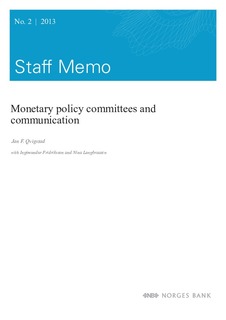| dc.contributor.author | Qvigstad, Jan F. | |
| dc.contributor.author | Fridriksson, Ingimundur | |
| dc.contributor.author | Langbraaten, Nina | |
| dc.date.accessioned | 2018-07-31T12:33:09Z | |
| dc.date.available | 2018-07-31T12:33:09Z | |
| dc.date.issued | 2013 | |
| dc.identifier.isbn | 978-82-7553-718-6 | |
| dc.identifier.issn | 1504-2596 | |
| dc.identifier.uri | http://hdl.handle.net/11250/2507015 | |
| dc.description.abstract | A country has only one central bank. It is therefore logical to compare it with central banks of other countries. There is broad agreement on the objective of monetary policy – price stability – and on central bank independence in the use of policy instruments to reach that objective. According to international best practice, monetary policy decisions should be made by committee, but neither theory nor practice provides any clear answers as to which committee type is the right one or which form of work practice is best. There is broad international agreement that monetary policy decisions should be transparent. However, the way transparency and central bank communication work in practice will depend among other things on whether the monetary policy committee is collegial or individualistic. | nb_NO |
| dc.language.iso | eng | nb_NO |
| dc.publisher | Norges Bank | nb_NO |
| dc.relation.ispartofseries | Staff Memo;2/2013 | |
| dc.rights | Attribution-NonCommercial-NoDerivatives 4.0 Internasjonal | * |
| dc.rights.uri | http://creativecommons.org/licenses/by-nc-nd/4.0/deed.no | * |
| dc.title | Monetary Policy Committees and Communication | nb_NO |
| dc.type | Working paper | nb_NO |
| dc.subject.nsi | VDP::Samfunnsvitenskap: 200::Økonomi: 210 | nb_NO |
| dc.source.pagenumber | 18 | nb_NO |

